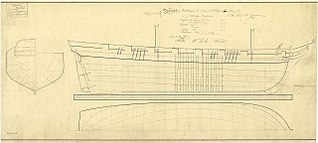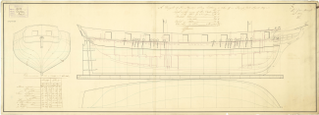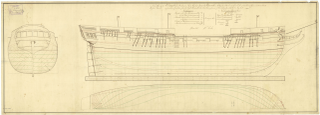
Scipion was a 74-gun French ship of the line, built at Lorient to a design by Jacques Noel Sane. She was laid down as Orient in late 1798, and renamed Scipion in 1801. She was first commissioned in 1802 and joined the French Mediterranean fleet based at Toulon, in the squadron of Admiral Leissègues. Consequently, she was one of the ships afloat in that port when war with England reopened in May 1803. She participated in the Battle of Cape Finisterre and the Battle of Trafalgar. The British captured her in the subsequent Battle of Cape Ortegal. In 1810 she participated in the Java campaign, which in 1847 earned her surviving crew the Naval General Service Medal. She participated in the blockade of Toulon in 1813 and was paid off in 1814. She was broken up in 1819.

HMS Standard was a 64-gun Royal Navy third-rate ship of the line, launched on 8 October 1782 at Deptford. She was the last of the 15 Intrepid-class vessels, which were built to a design by John Williams.

HMS Active was a Royal Navy fifth-rate frigate launched on 14 December 1799 at Chatham Dockyard. Sir John Henslow designed her as an improvement on the Artois-class frigates. She served during the French Revolutionary Wars and the Napoleonic Wars, capturing numerous enemy vessels. Her crews participated in one campaign and three actions that would later qualify them for the Naval General Service Medal. She returned to service after the wars and finally was broken up in 1860.

HMS Volage was a Laurel-class sixth-rate post-ship of the Royal Navy. She served during the Napoleonic War, capturing four privateers and participating in the Battle of Lissa (1811). She was sold in 1818. Her new owners renamed her Rochester and she served in a commercial capacity for another 12 years, first sailing between England and India, and then making two voyages to the South Seas as a whaler. She was last listed in Lloyd's List in 1831.
HMS Topaze was a Royal Navy 32-gun frigate, originally completed in 1791 as a French Magicienne-class frigate. In 1793 Lord Hood's fleet captured her at Toulon. The Royal Navy took her into service under her existing name. She was broken up in 1814.

HMS Herald was an 18-gun ship-sloop of the Cormorant class in the Royal Navy, launched in 1806 at Littlehampton. In 1810 she was reclassed as a 20-gun sixth rate ship, and again re-rated as 24 guns in 1817, just before she was broken up.
HMS Olympia was an Adonis-class schooner of the Royal Navy during the Napoleonic War. She was built at Bermuda using Bermudan cedar and completed in 1806. In March 1811 the French captured her, but the British recaptured her in October. During her career, she served as far afield as Buenos Aires, Île Bourbon, and Cape of Good Hope. The Admiralty sold her in 1815.

HMS Swallow was a Cruizer-class brig-sloop launched in December 1805, nine months late. She served the Royal Navy through the Napoleonic Wars, capturing numerous privateers. After the end of the wars she was broken up in 1815.

HMS Julia was a British Royal Navy 16-gun brig-sloop of the Seagull class launched in February 1806. After a fairly uneventful decade-long career she was wrecked at Tristan da Cunha in 1817 with heavy loss of life.

HMS Moselle was a Cruizer-class brig-sloop of the Royal Navy, launched in 1804. She served during the Napoleonic Wars in the Mediterranean, the Caribbean, and the North American station. She was sold in 1815.

HMS Minorca was a Cruizer-class brig-sloop of the Royal Navy, launched in 1805. She served during the Napoleonic Wars in the Mediterranean and was broken up after an uneventful career.

HMS Crocus was the nameship of the Crocus-class brig-sloops of the Royal Navy. She was launched in 1808 and had an almost completely uneventful career until she was sold in 1815. She then became a merchantman trading with the West Indies and the Mediterranean. She was last listed in 1823.

Nettuno was a French Illyrien or Friedland-class brig built at Venice and launched in June 1807. HMS Unite captured her a year later off Zara. The Royal Navy took her into service as HMS Cretan. She served in the Mediterranean. She was sold in 1814. Between 1815 and 1831 she made five voyages as a whaler.
Teulié was a French Illyrien or Friedland-class brig built at Venice and launched in April 1808. HMS Unite captured her some two months later off Zara. The Royal Navy took her into service as HMS Roman. She served in the Mediterranean. She was sold in 1814.
The French brig Nisus was a Palinure-class brig of the French Navy, launched in 1805. The Royal Navy captured Nisus at Guadeloupe in 1809. The British took her into service as HMS Guadaloupe, and sold her in November 1814.
HMS Venturer was launched at Livorno in 1807 as the French privateer Nouvelle Enterprise. The Royal Navy captured her in 1807 in the West Indies and initially took her into service. It renamed her Theodosia in 1808. She served in the Mediterranean until the Navy sold her in 1814. She then became the mercantile Theodosia. She traded between London and Rio de Janeiro and was last listed in 1822.

The Thames-class frigate was a 32-gun fifth-rate frigate class of eight ships of the Royal Navy based on the Richmond-class frigate designed by William Bately. The ships were ordered to the older design, which was of a smaller type of ship compared to more modern designs, so that they could be built quickly and cheaply in time to assist in defending against Napoleon's expected invasion of Britain. The class received several design changes to the Richmond class, being built of fir instead of oak, with these changes making the class generally slower and less weatherly than their predecessors, especially when in heavy weather conditions. The first two ships of the class, Pallas and Circe, were ordered on 16 March 1804 with two more ordered on 1 May and the final four on 12 July. The final ship of the class, Medea, was cancelled on 22 October before construction could begin but the other seven ships of the class were commissioned between 1804 and 1806.

HMS Dover was a 38-gun troopship, previously the French corvette Bellona, launched at Venice in 1808. She was captured at Lissa in 1811. She served as a troopship and transport until circa 1819. She then became the flagship for the Admiral commanding the Leith station. She was used for harbour service from 1825, and was sold in 1836.
HMS Diomede was a 50-gun fourth-rate ship of the line of the Diomede class of the Royal Navy. She was launched in 1798.
HMS Fly was launched in 1805. In 1807 she participated in one major naval campaign. She was wrecked on 28 February 1812 at Anholt Island in the Kattegat.












